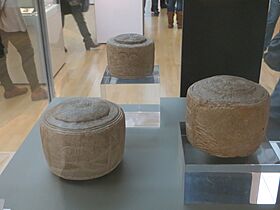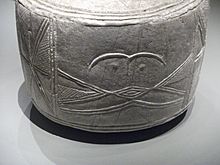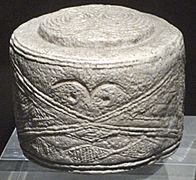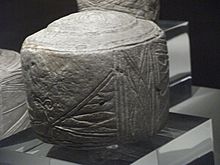Folkton Drums facts for kids
Quick facts for kids Folkton Drums |
|
|---|---|

Folkton Drums displayed in the British Museum
|
|
| Material | Chalk |
| Size | 8.7 cm (height) |
| Created | 2600–2100 BC |
| Discovered | 1889 |
| Present location | British Museum |
| Identification | P&EE 1893 12-28 15-17 |
The Folkton Drums are three special objects made from chalk. They look like drums or solid cylinders. These ancient items were made during the Stone Age in Europe. They were found in a child's grave near a village called Folkton in northern England.
Today, the Folkton Drums are on loan to the Stonehenge Visitor Centre. They usually belong to the British Museum. Another similar object, called the Lavant drum, was found in 1993.
No one knows for sure what the drums were used for. They are called "drums" because of their shape. However, experts do not think they were used as musical instruments.
Finding the Folkton Drums
In 1889, a scholar and archaeologist named William Greenwell opened an ancient burial mound. This mound was a round hill called a barrow. It was located near Folkton in North Yorkshire.
Inside the barrow, Greenwell found a grave from the Stone Age. This grave was from around the same time as Stonehenge, between 2600 and 2000 BC. He found the bones of several people. One of them was a child. The three drums were found right next to this child.
Finding these drums is very rare. This suggests that the child might have been from an important family. Four years after they were found, Greenwell gave the drums to the British Museum.
What the Drums Look Like
The three drum-shaped objects are made from chalk found nearby. They are decorated with designs that look like human faces. They also have geometric patterns.
On the top of the cylinders, there are several circles, one inside the other. Two of the drums have pairs of eyes. These eyes are drawn in a simple way to show a human face. The style of the drums is similar to objects made by the Beaker culture. This culture existed during the early British Bronze Age.
The exact use of the drums is still a mystery. The faces on them might show important people from the local group. Or, they could have been a special type of children's toy. Most toys from that time were made of wood and have not survived.
An archaeologist named Anne Teather has studied the drums. She noticed something interesting about their size. The distance around each drum (its circumference) is a whole number of times a "long foot." This was a unit of measurement used a lot in Neolithic Britain.
Teather thinks the drums might have been used to help people measure things the same way in different places. They could also have been tools for teaching. In 2005, Anne Teather also realized that the Lavant drum was very similar to the Folkton Drums.
Learn More
 In Spanish: Tambores de Folkton para niños
In Spanish: Tambores de Folkton para niños





